Stacatto - Death of a Right Whale - Harvard Forecasts of Potential Strike Locations
HARVARD OCEAN PREDICTION SYSTEM
Harvard Predicted Possible Strike Locations
Harvard Predicted Paths
National Marine Fisheries Service Press Release
Center for Coastal Studies
A.R. Robinson, P.J. Haley, Jr., P.F.J. Lermusiaux, W.G. Leslie
HARVARD UNIVERSITY
Division of Applied Sciences
Department of Earth and Planetary Sciences
Cambridge, Massachusetts
(617)495-2819
http://www.deas.harvard.edu/~robinson
Accessibility

In late May 1999, Harvard University was contacted by the National Marine
Fisheries Service (NMFS) Department of Compliance in order to help
"back-calculate the drifting trajectory of a
particular dead right whale to determine where it was struck by a ship."
The right whale Staccato had been found dead in Cape Cod Bay on 20 April. It had
last been observed alive off of Provincetown on 15 April. The assumption was
made, barring conflicting information determined from an autopsy, that during
that 5 day time span, Staccato was struck by a ship and fatally injured.
Injuring or causing the death of a whale is a criminal offense and the NMFS
hoped to determine the culprit by attempting to correlate potential strike
locations with the paths of vessels through Cape Cod Bay during the time
in question.
Harvard reseachers rapidly acquired all available data in Massachusetts Bay
from the Massachusetts Water Resources Authority (MWRA) for the months of
March and April 1999 as well as the necessary atmospheric forcing variables
from the Fleet Numerical Meteorological and Oceanography Center (FNMOC).
Using the Harvard Ocean Prediction System (HOPS), the
potential paths of the remains of "virtual whales" were estimated and forecast.
The HOPS model set simulated whales adrift from 800 different sites every
twelve hour for five days -- a total of 8,000 virtual drifters. In real time,
the program took about 8 hours to run.
The important virtual whales are the ones that drifted to the site where the real
whale, Staccato, was observed dead the evening of April 20. The HOPS results
show that if the Staccato died the evening of April 15, she most likely died in
a fairly small patch of water a few miles off Plymouth.
Predicted Possible Strike Locations
The plots below indicate the areas in which a trajectory of a virtual whale
ends within either 5km or 2km of the location at which Staccato was found
dead, given a fatal ship strike at a particular time. The colored ellipses
indicate all locations for which Staccato could have drifted to the location
at which it was disovered. The star is the location at which Staccato was
found dead. The gray circle around it is either 5km or 2km in radius,
depending on the plot. The gray lines show the normal ship paths from the
Cape Cod Canal to Boston or out to the Atlantic.
Possible Strike Locations

|
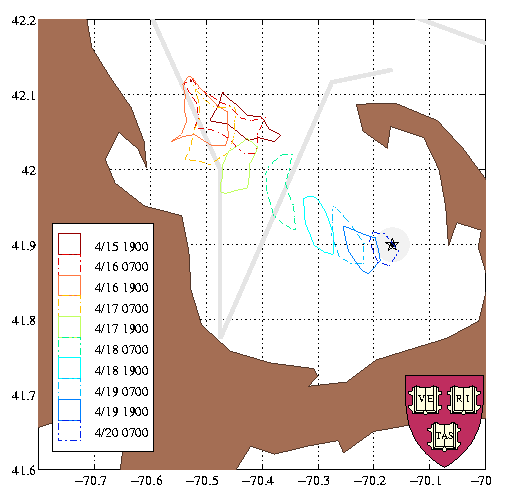
|
|
Possible strike locations which end within 5km of death site
|
Possible strike locations which end within 2km of death site
|
Return to top of document
Predicted Individual Paths
The figures below depict the potential predicted drift paths of the whale remains
for the period 15-21 April 1999 if struck and killed at 0700 or 1900 on the date
indicated. The white lines
indicate the paths of the bodies which end close to the final resting place of
Staccato, while the color contours indicate the possible
total distance a whale carcass would travel from any individual model grid point.
Predicted Drift After Death

|
|
Death at 1900 Local Time on 15 April
|
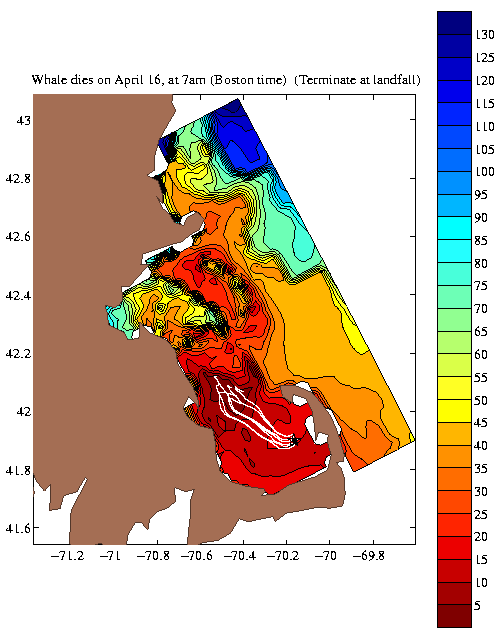
|
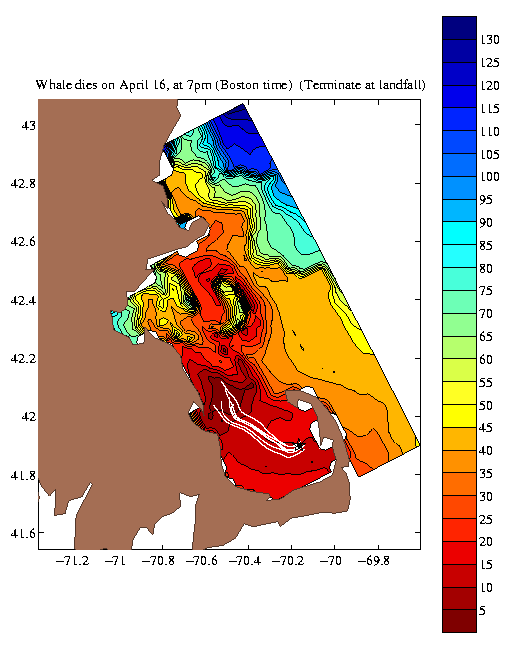
|
|
Death at 0700 Local Time on 16 April
|
Death at 1900 Local Time on 16 April
|
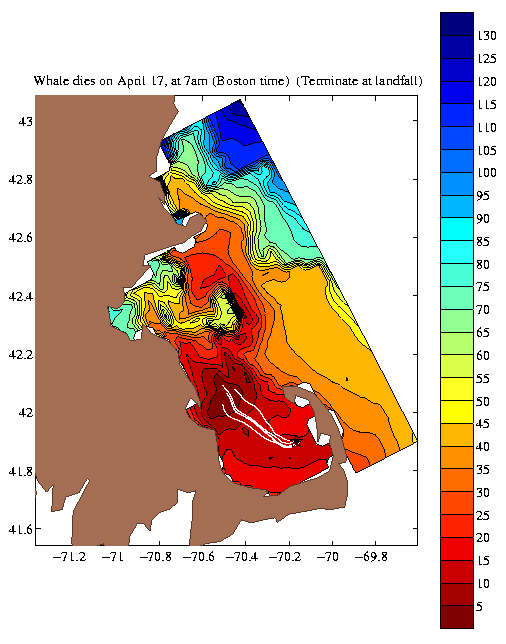
|
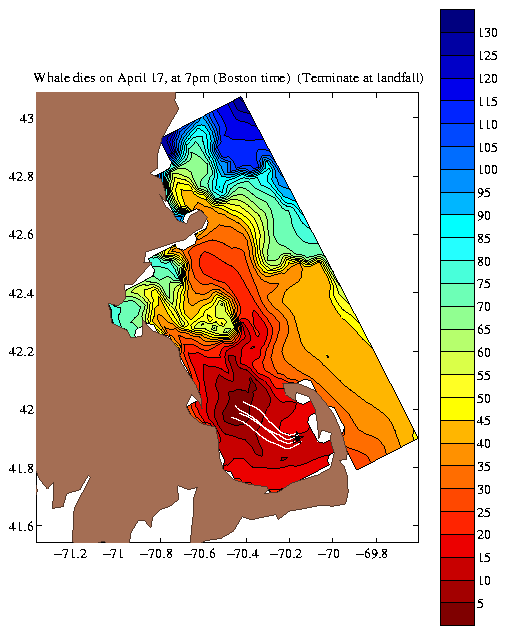
|
|
Death at 0700 Local Time on 17 April
|
Death at 1900 Local Time on 17 April
|
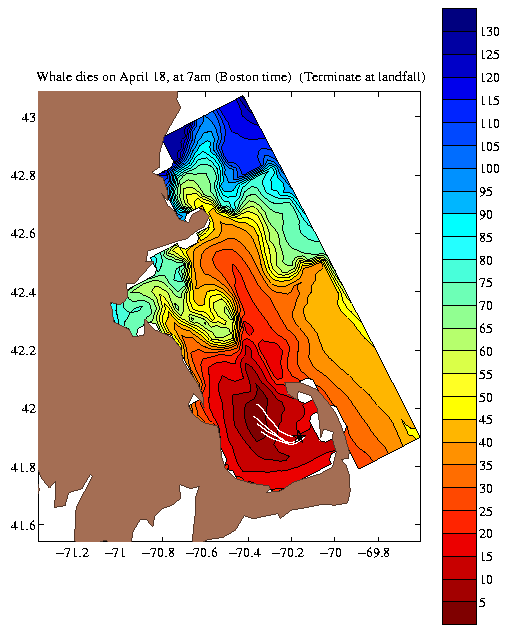
|
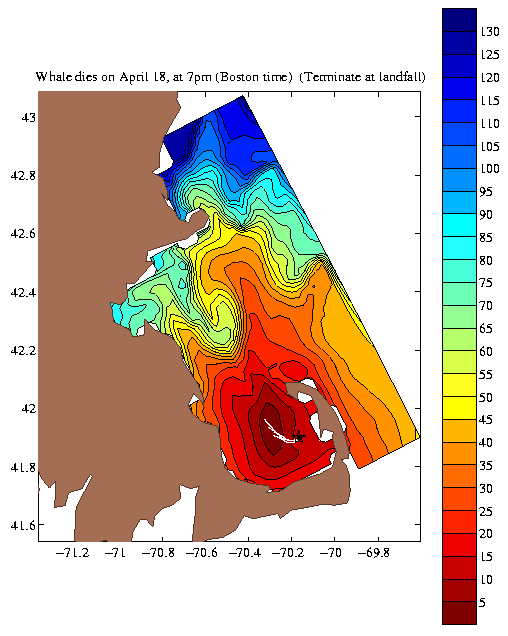
|
|
Death at 0700 Local Time on 18 April
|
Death at 1900 Local Time on 18 April
|
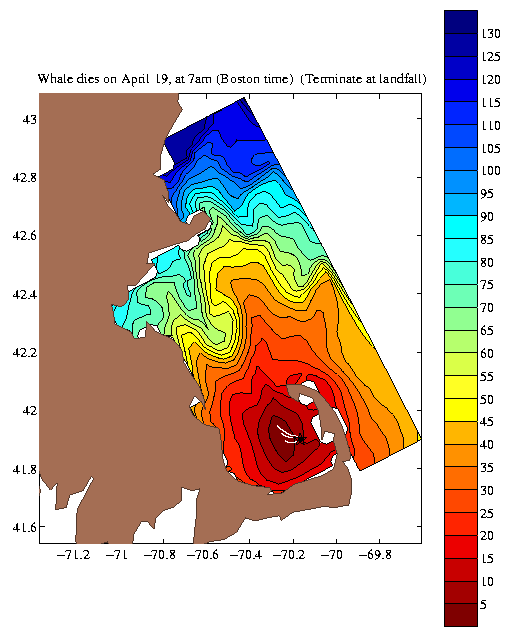
|
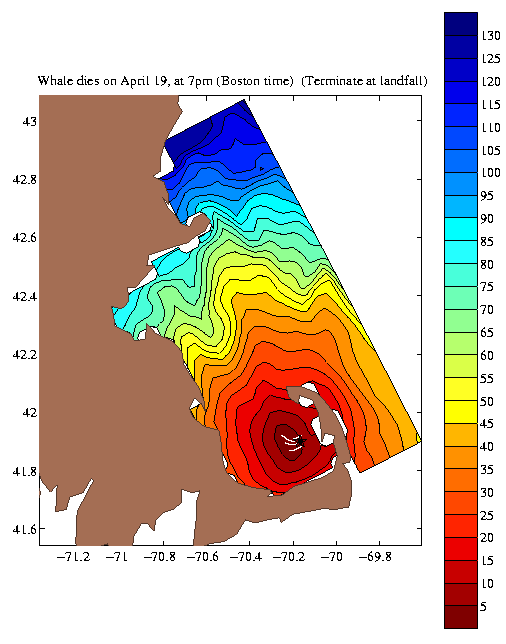
|
|
Death at 0700 Local Time on 19 April
|
Death at 1900 Local Time on 19 April
|
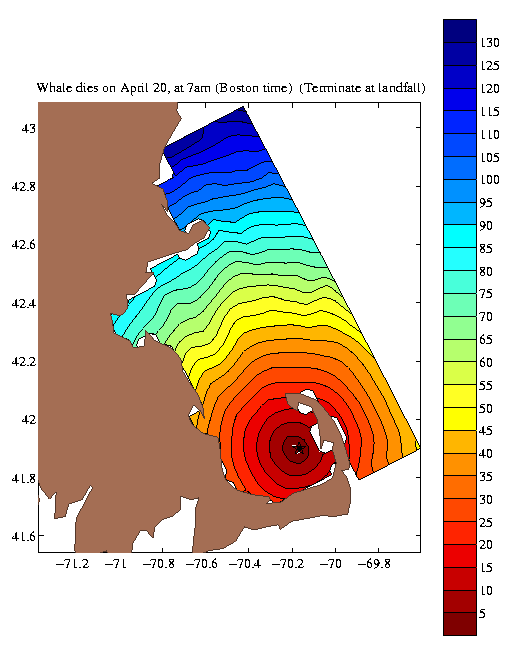
|
|
Death at 1900 Local Time on 20 April
|
Return to top of document
National Marine Fisheries Service Press Release
The National Marine Fisheries Service prepared this
press release to describe the Harvard work.
Return to top of document
Center for Coastal Studies
The Center for Coastal
Studies (CCS) described the situation in this manner:
While the cause of death of the right whale called
Staccato awaits further laboratory analysis, researchers at the CCS, who
discovered the carcass of the 60-ton animal floating in Cape Cod Bay on
April 20, today discounted the theory that the whale may have been too
ill to avoid the probable collision with a ship that broke its jaw and
back.
Based on extensive aerial surveys and zooplankton studies conducted
by CCS as part of the Massachusetts Division of Marine Fisheries' right
whale management program, Staccato is known to have arrived in Cape Cod
Bay in January and engaged in normal feeding behavior up until about a
week before her death, according to Dr. Charles "Stormy" Mayo, who directs
CCS's habitat studies.
The last known field observations of Staccato alive were made by CCS
aircraft and the habitat study team onboard R/V Shearwater on April 15
from 0845 to 1023. "The observations were made south of Provincetown Harbor
during an effort to study the relationship between feeding whales and the
food resources of Cape Cod Bay," said Mayo. "Staccato approached the research
vessel while plankton sampling proceeded. Three observers from CCS concluded
at the time that Staccato was behaving normally, apparently foraging
for patches of plankton."
An analysis of 26 plankton samples from the area where Staccato was
feeding supports the field observations that the whale was in an area of
moderate food quality and may have been searching for better feeding areas
in the region. These observations suggest that injuries sustained by Staccato
occurred after the time of the feeding observation on April 15.
Dr. Moira Brown, who directs the CCS aerial survey program, further
noted that Staccato was first seen this season by the CCS vessel R/V Shearwater
on January 17, 1999. Seven subsequent sightings of Staccato occurred
during aerial and vessel surveys in February, March and into mid-April
- (2/1, 3/3, 3/10, 3/14, 3/21, 4/6 4/15). "Throughout the season, her behavior
has appeared normal," said Brown.
Staccato was a regular winter and spring
visitor to the waters of Massachusetts and Cape Cod Bays for 25 years from
May of 1974 until the day she was found dead on April 20, 1999. In many
years, her only sighting for that year was in Cape Cod Bay, 70% of all
of her catalogued sightings occurred in Massachusetts waters and she has
been seen here each winter for the last five years. A prolific breeder,
Staccato gave birth to six calves between 1977 and 1997 and brought all
of them to Cape Cod Bay.
Return to top of document
Harvard Ocean Prediction System (HOPS)
HOPS is a flexible, portable and generic system for inter-disciplinary
nowcasting, forecasting and simulations. HOPS can rapidly be deployed to
any region of the world ocean, including the coastal and deep oceans and
across the shelfbreak with open, partially open or closed boundaries. Physical,
and acoustical, real time and at sea forecasts have been carried out for more
than fifteen years at numerous sites and coupled at sea biological forecasts
were initiated in 1997. The present system is applicable in waters from 10m depth
to several
thousand meters and the heart of the system is a primitive equation physical
dynamical model.
This page was last revised at 1115 3 November 2000.
Return to top of document












